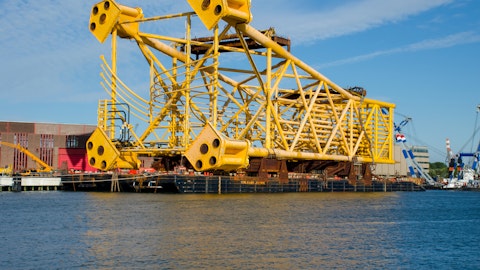Michael Ure: No color just yet. We haven’t actually put out our 2024 guidance, but definitely look forward on the next quarter call to walk through our expectations for 2024. We’re still in the process of receiving full information from a lot of our producers in terms of what their drilling plans and expectations are for the back half of this year and into the first part of next year that will be the primary drivers for what our expectations might be on volumetric growth for 2024. So as we gather that information and then are able to share that with the market on our call in the first quarter of next year, then we’ll definitely be able to walk through what our expectations might be on EBITDA growth.
Jeremy Tonet: Got it. That’s helpful there. And just want to shift to the DJ for a minute if I could and see that Williams kind of got a bit bigger in the base and I think they’re now the number 3 processor. Just wondering if this changes the competitive dynamics in any way or any other thoughts that you could share with us on the DJ at this point?
Michael Ure: Yes, it’s a great question. Definitely don’t foresee that having a meaningful impact on us in terms of the competitive dynamics. Williams is a great company and so the fact that they’re investing as much as they are on the DJ, obviously is very positive sign from our perspective, corroborates our view of the basin as a whole and the highly prolific nature of that basin, but certainly wouldn’t expect that it would have a meaningful impact on us.
Jeremy Tonet: Got it. And if I could just sneak one last one in for the Meritage acquisition, just wondering on a per unit basis, is this accretive or dilutive to per MCF or per barrel fee and just how do you see the trajectory from this business over time?
Kristen Shults: It’s — so it would be accretive on a per MCF basis. So I actually expect in Q4 to see our gross margin per MCF increase just a little bit as we add those Meritage volumes into our throughput numbers.
Jeremy Tonet: Got it. That’s helpful. I’ll get back in the queue. Thanks.
Michael Ure: Thanks, Jeremy.
Operator: [Operator Instructions] Our next question comes from the line of Neel Mitra with Bank of America. Your line is open.
Neel Mitra: Hi, thanks for taking my question. I just wanted to understand maybe the rationale going forward underpinning distribution increases now that Meritage is in the mix and debt is a little bit higher. I wanted to understand the priorities with capital allocation and when you look at distribution increases, do you have a formula where you look at payout ratios or a percentage of CFO? Just wanted to understand the background behind that and how you’re looking at that going forward?
Michael Ure: Yes, it’s a great question, Neel. So our primary driver is that we want to be able to set the base distribution at a level that we believe is sustainable over time. And so the reason for actually now the multiple increases in the base distribution that we’ve had this year were primarily for the first one, the fact that we had received close to BCF of incremental commitments overall since we could established that primary base distribution level and the fact that we’re spending as much growth capital as we are, which would indicate stronger sustainability from a free cash flow perspective as we go over time. With the most recent increase in the distribution, it was the fact that we’re bringing on incremental free cash flow through the Meritage acquisition, so therefore our expectation of a sustainable level increased in light of that new free cash flow is coming online with that transaction.
And so when we look at it on a quarterly basis, we’re looking at what do we believe is actually a sustainable base distribution level going forward. We haven’t actually made any changes at all in terms of our prioritization of return of capital for the remaining free cash flow that we have on an annual basis. We’re always looking at opportunistic ways that we can deploy that capital. So for example if in a particular period we think it’s of greater benefit to pay down debt, then we’ll pay down debt. If there’s greater opportunities on the unit repurchase side, then we’ll do that. And obviously this year you’ve actually seen pretty much both of those things through debt repurchases, unit repurchases as well as the addition of Meritage into the company.
And so that’s going to continue to be our levers that we pull and as we have potentially continued progress in terms of our expectations, sustainability of that base distribution going forward, then we’ll look at it on a quarterly basis with the Board and determine whether or not we think it warrants an increase overall. If we have superior year-on-year performance relative to expectations and that puts us in a place to be able to pay an enhanced distribution as we meet those criterion that we’ve highlighted in our slides and then that’s where the base distribution comes in to pay out that incremental value relative to our expectations for that period. So I hope Neel that answers your question.
Neel Mitra: Yes, that’s very helpful. I appreciate it. And just as a follow up, I know you can’t answer where the numbers shake out, but maybe you could just kind of outline the factors that go into cost of service for the calculation next year? I know the wells return on line later than expected, similar commodity prices, but as I understand it, it’s backward looking and forward-looking and there’s some other components. So are there any general themes that we should look at going into next year?
Michael Ure: Yes. It’s a great question, Neel. So the way that that calculation works is that it takes the previous period, so in this instance it would be 2023 relative to our expectations of free cash flow under those contracts for 2023 and combines that with the expectations of the free cash flow out through the end of the period of those contracts and then determines in accordance with what the predetermined rate would be, what the fees would ultimately need in order to generate that rate of return. So in a scenario where there’s under performance on the volumes, if all expectations were held flat the same as they were before into future periods, you would expect that those rates would have to go up in order to generate the same expected rate of return that was expected as of the previous year when that rate was determined.
So does that hopefully give you a little bit of context to how that works? As we sit here today, we don’t know quite yet what those long-term forecasts would be in order to generate that rate and then what the cost would be in order to bring those volumes onto the system to generate that return. That will occur throughout the end of this year and into the first part of next wherein we’ll be able to give a little bit more information on our expectations for 2024 EBITDA and capital.
Neel Mitra: Okay, got it. That’s very helpful. Thank you.
Michael Ure: Thank you, Neel.
Operator: And the next question comes from the line of Gabe Moreen with Mizuho. Your line is open.
Gabriel Moreen: Hey, good afternoon everyone. Maybe if I could just start with a quick clarification on the CapEx spend next year. What Kristen talked about it being a heavier year, is that just heavier compared to 2023? I just wanted to clarify that.
Kristen Shults: Yes, that’s right, Gabe. So heavier compared to what Meritage was spending in 2023. I think when we looked at doing the due diligence on that, historically you’re looking around $50 million kind of a run rate CapEx spend for an asset like that and so heavier relative to that, just slightly.



